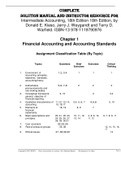Exam (elaborations)
Solution Manual for Intermediate Accounting, 18th Edition, by Donald E. Kieso, Jerry J. Weygandt and Terry D. Warfield. Chapter 1-23
Solution Manual and Instructor Resource for Intermediate Accounting, 18th Edition, by Donald E. Kieso, Jerry J. Weygandt and Terry D. Warfield. ISBN-13 978-6 Solution Manual for Intermediate Accounting 18th Edition by Donald E. Kieso, Jerry J. Weygandt and Terry D. Warfield. Chapter 1-23 TABLE OF...
[Show more]



